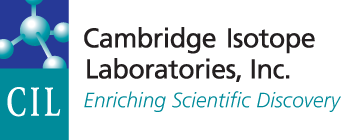Dimethyl Labeling
The dimethyl labeling technique uses a reagent mixture (i.e., cyanoborohydride and formaldehyde in their unlabeled and stable isotope-labeled forms) to tag primary amines (i.e., the N-terminus and the ε-amino group of lysine) in proteins or peptides. This is a fast, straightforward, and inexpensive approach to conduct 2- or 3-plex quantitative proteomic analyses of a variety of sample types (e.g., lysate, tissue). To facilitate reductive amination reactions in quantitative proteome profiling (example provided in App Note 38), CIL is pleased to offer a variety of chemical tagging reagents.
Related Resource
Stable Isotope Dimethyl Labeling
Related Products
Frequently Asked Question
At what stage of a bottom-up proteomics experiment are the dimethyl labeling reagents inserted? The reductive methylation reagents (i.e., formaldehyde and cyanoborohydride) are typically added to peptides post-digestion.
Example References
Agbani, E.O.; Young, D.; Chen, S.A.; et al. 2023. Membrane procoagulation and N‑terminomics/TAILS profiling in Montreal platelet syndrome kindred with VWF p.V1316M mutation. Commun Med, 3(1), 125-133. PMID: 37735203
Son, A.; Pankow, S.; Bamberger, T.C.; et al. 2023. Quantitative structural proteomics in living cells by covalent protein painting. Methods Enzymol, 679, 33-63. PMID: 36682868
Nickerson, J.L.; Doucette, A.A. 2022. Maximizing cumulative trypsin activity with calcium at elevated temperature for enhanced bottom-Up proteome analysis. Biology (Basel), 11(10), 1444-1459. PMID: 36290348
Yan, X.; Sun, L.; Dovichi, N.J.; et al. 2020. Minimal deuterium isotope effects in quantitation of dimethyl-labeled complex proteomes analyzed with capillary zone electrophoresis/mass spectrometry. Electrophoresis, 41(15), 1374-1378. PMID: 32548848
Zhang, Y.; Xie, X.; Zhao, X.; et al. 2018. Systems analysis of singly and multiply O-glycosylated peptides in the human serum glycoproteome via EThcD and HCD mass spectrometry. J Proteomics, 170, 14-27. PMID: 28970103
Hsu, J.L.; Chen, S.H. 2016. Stable isotope dimethyl labelling for quantitative proteomics and beyond. Philos Trans A Math Phys Eng Sci, 374(2079), 20150364. PMID: 27644970
Lai, Z.W.; Bolm, L.; Fuellgraf, H.; et al. 2016. Characterization of various cell lines from different ampullary cancer subtypes and cancer associated fibroblast-mediated responses. BMC Cancer, 16, 195. PMID: 26951071
Weißer, J.; Lai, Z.W.; Bronsert, P.; et al. 2015. Quantitative proteomic analysis of formalin-fixed, paraffin-embedded clear cell renal cell carcinoma tissue using stable isotopic dimethylation of primary amines. BMC Genomics, 16(1), 559. PMID: 26220445
Tolonen, A.C.; Haas, W. 2014. Quantitative proteomics using reductive dimethylation for stable isotope labeling. J Vis Exp, (89), 51416. PMID: 25045933
Munoz, J.; Low, T.Y.; Kok, Y.J.; et al. 2011. The quantitative proteomes of human-induced pluripotent stem cells and embryonic stem cells. Mol Syst Biol, 7, 550. PMID: 22108792
